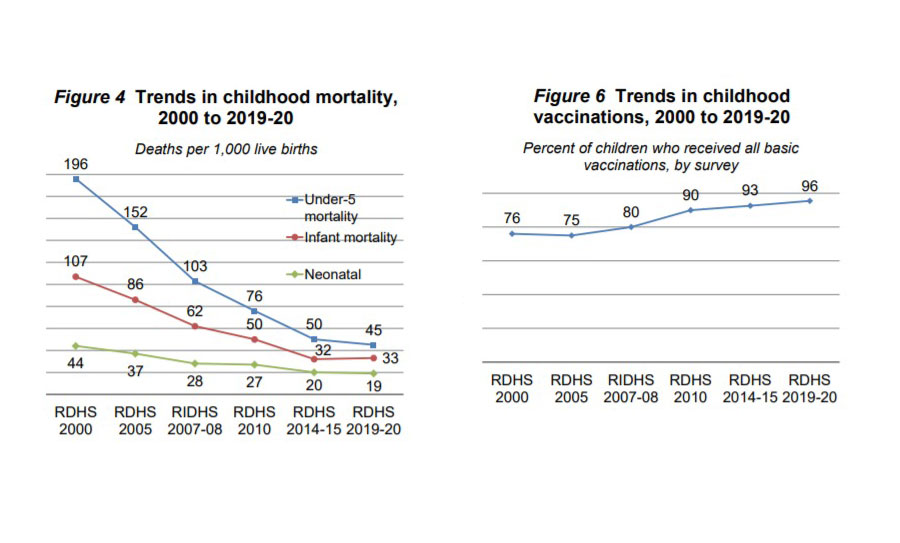The freshly released key indicators of the Rwanda Demographic and Health Survey brought news about the progress made by the country in terms of service delivery and maternal and child health improvement. Today in Rwanda, 96% of children below 2 years are fully vaccinated with basic vaccines. 99% of pregnant women get at least one visit by a health care providers during pregnancy and 93% of deliveries are performed at a health facility. Maternal mortality dropped from 1071 per 100,000 women in 1992 to 203 in 2020. (As per International Conference on Population and Development commitments, the number has to be 70 by 2030)

Rwanda Demographic and Health Survey (RDHS) reports have always been capital in the processes of policy making and planning in the field of health and population and other areas in both public and private sectors. Speaking at the official unveiling of the sixth RDHS key indicators Dr Daniel Ngamije Minister of Health emphasized on the fact that results from surveys such as RDHS should guide political intervention in concerned sectors.
“These results will allow us to further tailor our projects and programs to improve outcomes in the health sector, to monitor and evaluate the implementation of health programs and policies of the National Strategy for Transformation through Seven Years Government Plan (7YGP), Vision 2050, and the commitments which the Government has subscribed at both regional and global levels,” said Dr Ngamije.
Though RDHS2020 showcased Rwandan progress mainly in terms of maternal and child health, one indicator seemed to have underperformed; trends in insecticide-treated nets (ITN) ownership. Five years ago the peak was at 83% of families who owned an insecticide-treated net. Today the trend is at 66%. According to Dr Sabin Nsanzimana the Director General of the Rwanda Biomedical Centre, though distribution of ITNs has been heavily hampered by the COVID19-related lockdown, this drop reveals another critical information in regards with where governments efforts should be concentrated while fighting malaria.
“When we compare the results obtained with the use of ITNs to those we obtained in districts where we conducted indoor residual spraying (IRS) the contrast is striking. IRS is the way to go if we are set to eliminate malaria,” said Dr Nsanzimana
The sixth RDHS2019-20 was conducted in Rwanda following those implemented in 1992, 2000, 2005, 2010, and 2014-15. The National Institute of Statistics (NISR), in collaboration with the Ministry of Health (MOH), implemented the survey. Data collection took place from November 9, 2019, to July 20, 2020. The data collection was interrupted for more than 2 months from March 21 to June 7, 2020, due the nationwide lockdown for the Coronavirus disease (COVID-19) pandemic. Funding for the 2019-20 RDHS was provided by the government of Rwanda, the United States Agency for International Development (USAID), the One United Nations (ONE UN), the Centers for Disease Control and Prevention (CDC), the United Nations Children’s Fund (UNICEF), the United Nations Population Fund (UNFPA), UNWOMEN, and Enabel. ICF provided technical assistance through The DHS Program, which assists countries in the collection of data to monitor and evaluate population, health, and nutrition programs.